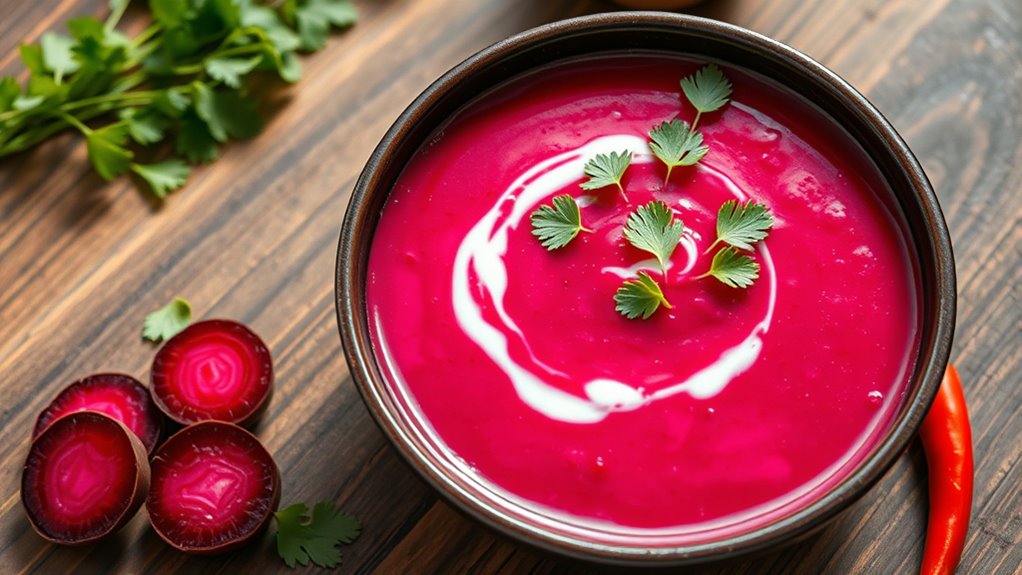You’ll start with tender beets cooked in a savory stock, then brighten the pot with garlic, ginger, and a touch of soy for that Chinese silhouette. Add onion, potato for body, and a splash of rice vinegar to balance sweetness. Simmer until the flavors fuse, taste for salt, and finish with a squeeze of lemon to preserve color. A smoky paprika or chili oil variation keeps things exciting, and there’s more to uncover beyond the surface.
Ingredients and Quantity
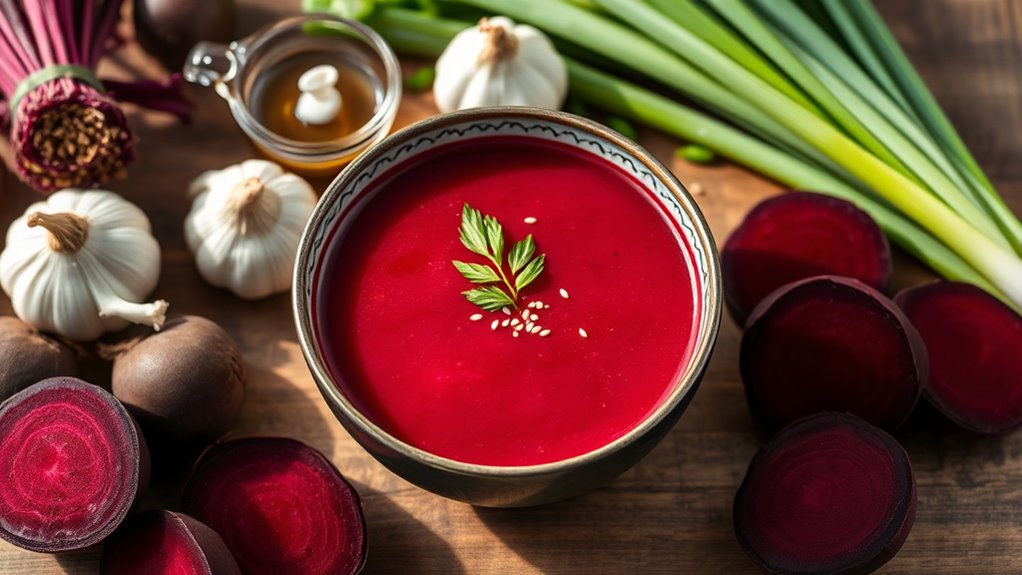
To make the beetroot soup, gather ingredients with precision: 4 medium beets, 1 liter of vegetable or chicken stock, 1 onion, 2 cloves of garlic, 1 potato for body, 2 tbsp olive oil, 1 tbsp lemon juice, and salt and pepper to taste; you can adjust the acidity with a pinch of sugar if needed.
| Ingredient | Quantity | Purpose |
|---|---|---|
| Beets | 4 | Color and sweetness |
| Stock | 1 L | Base flavor |
| Onion | 1 | Depth and aroma |
You seek health benefits through balanced components, while exploring flavor variations with lemon brightness and garlic punch. You approach measurements like clues to a puzzle, precise yet free, inviting curiosity and confidence in your kitchen.
Preparations
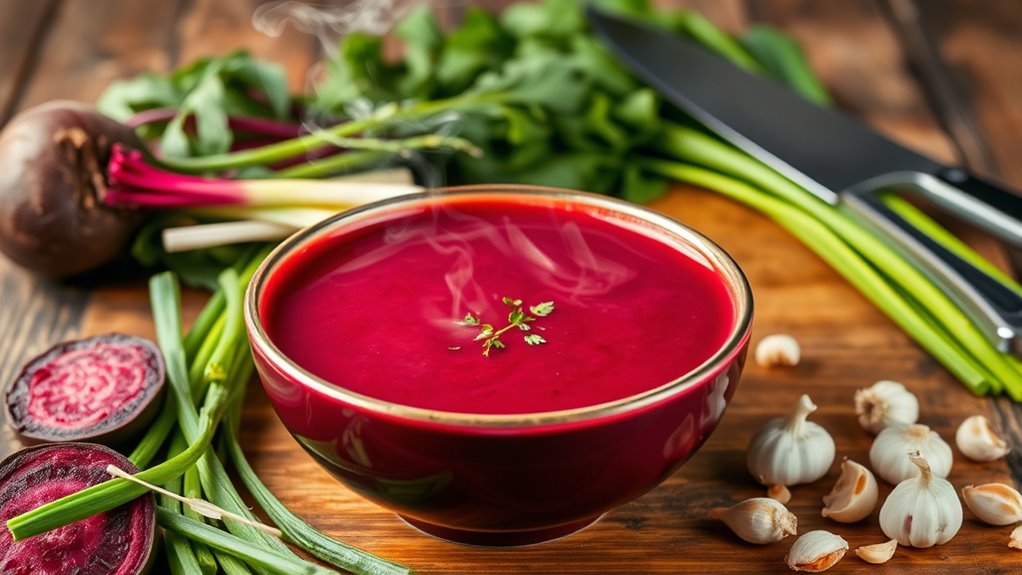
Before you begin simmering, prep with purpose: scrub the beets clean, trim the tops, and rub off any stubborn skins to reveal the deep, earthy color you’re aiming for. You’ll proceed with deliberate cuts, halving stubborn roots to guarantee even heat. Keep a steady pace, peeling away any blemishes, then rinse until the water runs clear. Dry thoroughly so moisture won’t dull the simmer. In a controlled pot, introduce aromatics—ginger, garlic, scallions—then seal in aroma with a light drizzle of oil. Track temperatures, not just time, so flavors don’t scorch. Employ precise knife work for uniform chunks, maximizing surface area for flavor. Preparation techniques matter here; consistent sizing supports even cooking. Flavor enhancements emerge through measured additions: salt, a splash of soy, a hint of rice wine.
Kitchen tools or Kitchenware Required
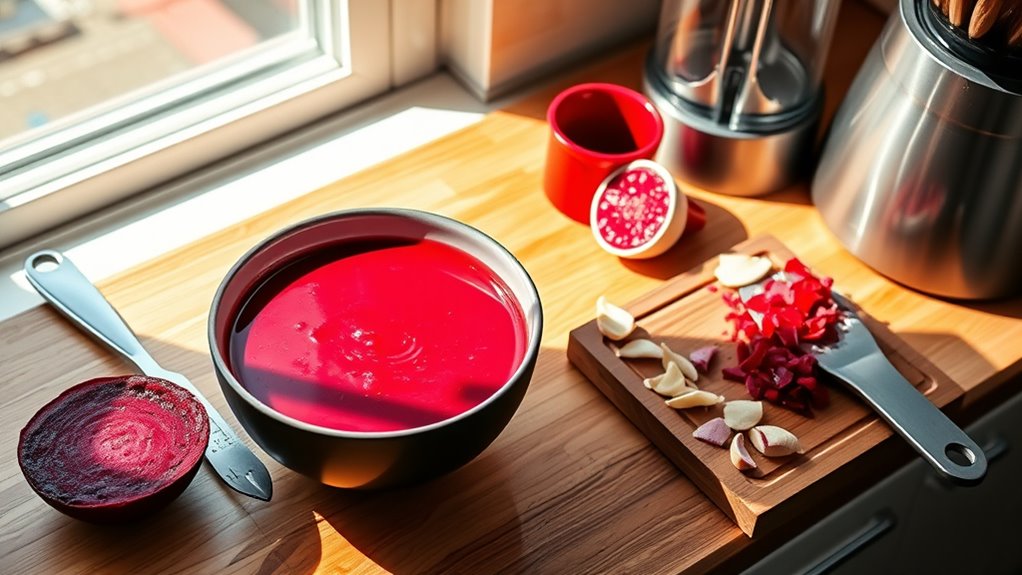
After prepping with careful precision, you’ll want a reliable setup: a sturdy, heavy-bottom pot for even heat distribution; a sharp chef’s knife for clean, safe cuts; and a cutting board with a grip to keep your workspace steady.
Kitchen tools shape kitchen organization and signal essential utensils you’ll reach for. You’ll pair mindful storage with function, keeping essentials accessible while you explore flavors. A ladle, tongs, peeler, and measuring spoons round out the core kit, each chosen for reliability and ease. Think of your utensils as extensions of planning: deliberate, efficient, unrestrictive. The right tools invite freedom to experiment, while maintaining control over texture and timing.
| Tool | Purpose |
|---|---|
| Ladle | Skimming, serving |
| Peeler | Peel, trim |
How to Cook
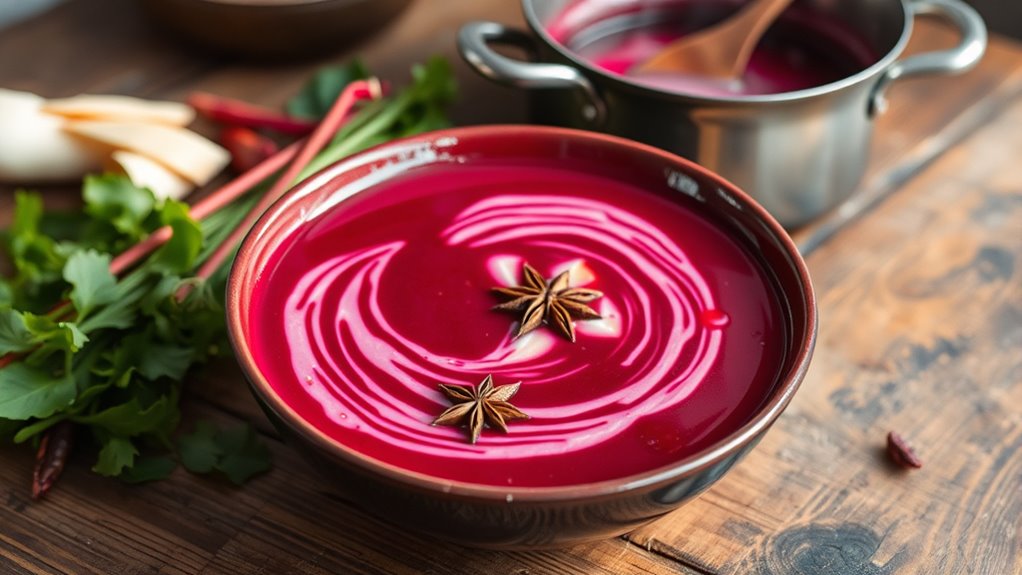
- Rinse the beets thoroughly to remove any soil.
- Trim the beet tops before cutting.
- Simmer the beets in broth with onions, garlic, and a splash of rice vinegar to balance acidity and sweetness.
- Close the pot and let the steam loosen the tough skins.
- Peel the beets and chop them into even cubes for consistent cooking.
- Add aromatics such as ginger, star anise, or a bit of soy sauce for a Chinese flavor twist.
- Heat gently, maintaining a calm simmer.
- Taste periodically to balance flavors: mellow sweetness, mineral earthiness, bright tang, and savory depth.
- Adjust salt as needed.
- Finish with a drizzle of sesame oil.
- Record techniques to understand and replicate the dish’s complexity.
How to Serve
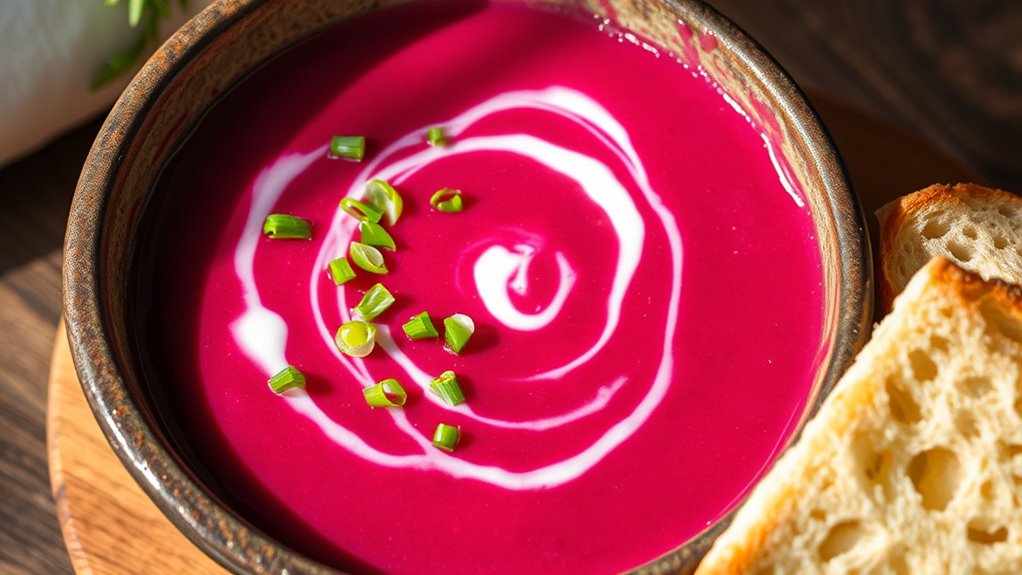
Once the beetroot soup is finished, set the scene for serving by choosing vessels that showcase its color and aroma; warm, wide bowls or shallow, rustic dishes let the broth glisten and pearls of beet float invitingly. You’ll plate with intention: pour slowly to preserve sheen, then breathe in the scent of earth and citrus, noting the contrast with any crisp garnish. For garnishing options, consider a whisper of sesame oil, a sprinkle of scallion chiffonade, or a dollop of tangy yogurt to balance sweetness. Serving suggestions lean toward communal texture and balance—pair with crisp bread or steamed greens. Keep the presentation simple, confident, and free; let the soup’s vibrant hue guide the eye and the palate.
Tips
To make beetroot soup really sing, start with fresh ingredients and precise preparation. In this tips section, you’ll notice small moves that sharpen flavor and texture without overcomplicating the process. Balance sweetness and earthiness by tasting as you go, adjusting salt, a splash of rice vinegar, and a touch of sesame oil for depth. Maintain vibrant color by adding a squeeze of lemon just before serving; this also brightens flavors. When simmering, keep the lid ajar to reduce steam and prevent muddiness. Consider beetroot benefits beyond color: a gentle acidity can lift aromatics, while coriander seeds or ginger introduce clean spice notes. For variety, explore soup variations like smoky paprika or chili oil, but preserve the Chinese-inspired backbone.
Food Value and Benefit
Beetroot soup is a nutritious and flavorful dish that offers a range of health benefits through its balanced ingredients.
Food Value:
- Contains natural sugars, dietary fiber, and nitrates
- Provides vitamins such as folate (Vitamin B9) and antioxidants
- Rich in minerals including potassium
- Low in fat, promoting a light and mindful eating experience
Benefits of Eating Beetroot Soup:
- Supports steady energy levels and helps regulate blood pressure due to nitrates
- Enhances cellular repair and boosts immune resilience with folate and antioxidants
- Offers anti-inflammatory properties through betalains, the natural pigments in beetroot
- Aids digestion and promotes a feeling of lightness thanks to dietary fiber
- Contributes to fluid balance and proper nerve function with potassium
- Supports mental clarity and overall well-being
Enjoying this Chinese-inspired beetroot soup provides a wholesome, nutrient-rich option that aligns with a health-conscious lifestyle.
Frequently Asked Questions
Can I Use Canned Beetroot for This Recipe?
Yes, you can. Canned beetroot works, but expect softer texture and milder flavor; drain well. Canned beetroot may alter color and sweetness. Compare flavor, note differences, and adjust seasoning to maintain the intended flavor profile.
Is Beetroot Safe for Pregnant or Breastfeeding Individuals?
Yes, you can, but you should consult a clinician first. You’ll weigh Nutritional benefits against Potential risks, monitor your blood pressure, and consider pasteurized forms if needed; individual tolerance varies, and recommendations emphasize moderation for pregnancy and breastfeeding.
Can I Make This Soup Spicy or With Chili Oil?
Yes, you can make it spicy. Try adding chili oil options or spicy variations to taste, and adjust heat gradually as you investigate flavors. You’ll discover balance, aroma, and freedom in each bold, precise bite.
How Long Does This Soup Keep in the Fridge?
Shelf Life: typically 3–4 days in the fridge. Storage Tips: cool promptly, airtight container, refrigerate within two hours, reheat gently. If it smells off or shows mold, discard. You’ll enjoy safe leftovers if you follow these checks.
Can I Freeze Beetroot Soup After Cooking?
Yes, you can freeze beetroot soup after cooking. For best quality, use airtight containers, leave headspace, and label with date. Freezing tips: chill first, then freeze in portions; consider Soup storage safety and thawing methods.
